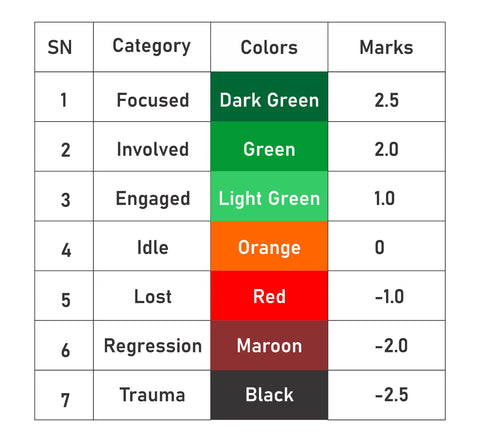Amidst so many daily activities parents do for their children, they are always sceptical about their progress. How do parents know that the child is progressing in the right direction? SpeechGears has developed a 'Child's Weekly Progress Chart', marking daily progress and progression graphs. Brain Development & Cognition Integration is at the core of a child's development. Other factors such as
(1) Sensory Integration.
(2) Speech, Language & Communication.
(3) Different levels of play.
(4) Socialization & Social Communication.
(5) Low body tone & whole-body movement.
(6) Awareness of the body & awareness of the environment etc.
Weekly Progress Chart help the brain to develop. SpeechGears specifically stresses cognition development because it is a master of the body & different systems. Once the brain takes charge, it controls the Sensory Systems of the body and the child becomes composed with growing age.
We categorise every activity of a child into 7 different merits.
The categorization of activity is subjective and differs from child to child. A focused activity for one child may be an Involved activity for another. Parents have to decide the class of the activity and its marks after that. Examples below.
Focused:
Solving Puzzles the First Time | Solving Legos | Participation in Quiz Contest | Writing Examination | Participation in the Race Competition | Etc..
Involved:
Play | Therapy | Cycling | Scatting | Dancing |Swimming | Tantrum | Swinging by Shelf | Reading | Writing | Etc..
Engaged:
Eating | Daily Chores | Walking | Waiting | Crying | Travelling |Swinging by Others | Trampoline
Idle:
Sleeping | Snoozing | Fever | Hospitalized
Lost:
Stimming | Aimless Running | Queueing Objects |Illness | Scold which child can’t decipher |Screen Time less than 20 minutes
Regression:
Screen Time of more than 40 minutes
Trauma:
Epilepsy | Seizures | Stroke
Rules:
(1) Assess the activity on a half-hourly basis.
(2) Color the triangle accordingly.
(3) Write the average marks for an hour on the block.
(4) Then sum up the marks for a day.
(5) Regression for two blocks in a row results in red flags.
(6) Stroke twice in a day results in black flags.
(7) Red flags on any given day will reset the day score to 'zero’.
(8) Black flags on any day of the week reset the week score ‘zero’ for that week.
A normal child scores at least 15 in a day and at least 110 in a week.
Source Url: https://shorturl.at/jwyGO


